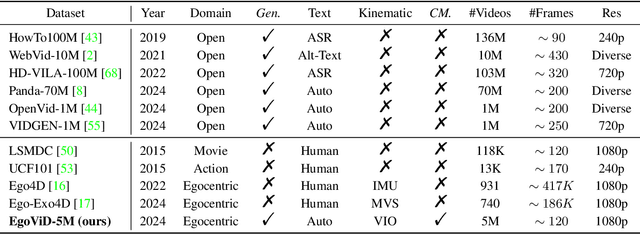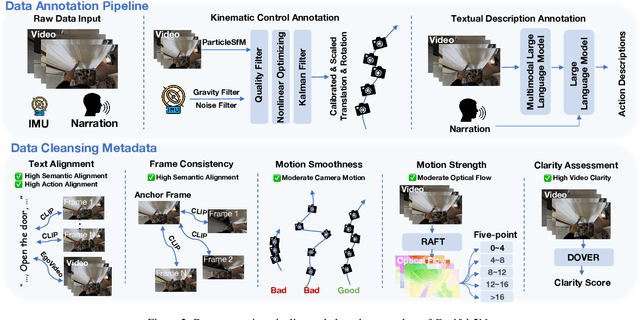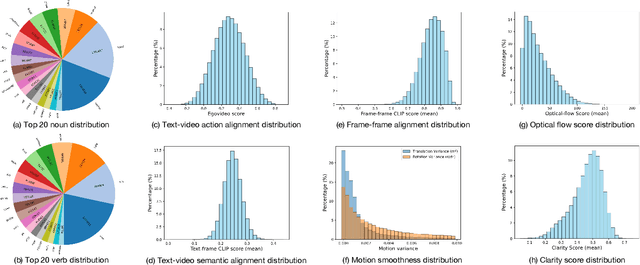Yingya Zhang
Self-Contradiction as Self-Improvement: Mitigating the Generation-Understanding Gap in MLLMs
Jul 22, 2025Abstract:Despite efforts to unify multimodal generation and understanding tasks in a single model, we show these MLLMs exhibit self-contradiction where generation produces images deemed misaligned with input prompts based on the model's own understanding. We define a Nonunified score that quantifies such self-contradiction. Our empirical results reveal that the self-contradiction mainly arises from weak generation that fails to align with prompts, rather than misunderstanding. This capability asymmetry indicates the potential of leveraging self-contradiction for self-improvement, where the stronger model understanding guides the weaker generation to mitigate the generation-understanding gap. Applying standard post-training methods (e.g., SFT, DPO) with such internal supervision successfully improves both generation and unification. We discover a co-improvement effect on both generation and understanding when only fine-tuning the generation branch, a phenomenon known in pre-training but underexplored in post-training. Our analysis shows improvements stem from better detection of false positives that are previously incorrectly identified as prompt-aligned. Theoretically, we show the aligned training dynamics between generation and understanding allow reduced prompt-misaligned generations to also improve mismatch detection in the understanding branch. Additionally, the framework reveals a potential risk of co-degradation under poor supervision-an overlooked phenomenon that is empirically validated in our experiments. Notably, we find intrinsic metrics like Nonunified score cannot distinguish co-degradation from co-improvement, which highlights the necessity of data quality check. Finally, we propose a curriculum-based strategy based on our findings that gradually introduces harder samples as the model improves, leading to better unification and improved MLLM generation and understanding.
DFVEdit: Conditional Delta Flow Vector for Zero-shot Video Editing
Jun 26, 2025Abstract:The advent of Video Diffusion Transformers (Video DiTs) marks a milestone in video generation. However, directly applying existing video editing methods to Video DiTs often incurs substantial computational overhead, due to resource-intensive attention modification or finetuning. To alleviate this problem, we present DFVEdit, an efficient zero-shot video editing method tailored for Video DiTs. DFVEdit eliminates the need for both attention modification and fine-tuning by directly operating on clean latents via flow transformation. To be more specific, we observe that editing and sampling can be unified under the continuous flow perspective. Building upon this foundation, we propose the Conditional Delta Flow Vector (CDFV) -- a theoretically unbiased estimation of DFV -- and integrate Implicit Cross Attention (ICA) guidance as well as Embedding Reinforcement (ER) to further enhance editing quality. DFVEdit excels in practical efficiency, offering at least 20x inference speed-up and 85\% memory reduction on Video DiTs compared to attention-engineering-based editing methods. Extensive quantitative and qualitative experiments demonstrate that DFVEdit can be seamlessly applied to popular Video DiTs (e.g., CogVideoX and Wan2.1), attaining state-of-the-art performance on structural fidelity, spatial-temporal consistency, and editing quality.
Taming Consistency Distillation for Accelerated Human Image Animation
Apr 15, 2025Abstract:Recent advancements in human image animation have been propelled by video diffusion models, yet their reliance on numerous iterative denoising steps results in high inference costs and slow speeds. An intuitive solution involves adopting consistency models, which serve as an effective acceleration paradigm through consistency distillation. However, simply employing this strategy in human image animation often leads to quality decline, including visual blurring, motion degradation, and facial distortion, particularly in dynamic regions. In this paper, we propose the DanceLCM approach complemented by several enhancements to improve visual quality and motion continuity at low-step regime: (1) segmented consistency distillation with an auxiliary light-weight head to incorporate supervision from real video latents, mitigating cumulative errors resulting from single full-trajectory generation; (2) a motion-focused loss to centre on motion regions, and explicit injection of facial fidelity features to improve face authenticity. Extensive qualitative and quantitative experiments demonstrate that DanceLCM achieves results comparable to state-of-the-art video diffusion models with a mere 2-4 inference steps, significantly reducing the inference burden without compromising video quality. The code and models will be made publicly available.
UniAnimate-DiT: Human Image Animation with Large-Scale Video Diffusion Transformer
Apr 15, 2025Abstract:This report presents UniAnimate-DiT, an advanced project that leverages the cutting-edge and powerful capabilities of the open-source Wan2.1 model for consistent human image animation. Specifically, to preserve the robust generative capabilities of the original Wan2.1 model, we implement Low-Rank Adaptation (LoRA) technique to fine-tune a minimal set of parameters, significantly reducing training memory overhead. A lightweight pose encoder consisting of multiple stacked 3D convolutional layers is designed to encode motion information of driving poses. Furthermore, we adopt a simple concatenation operation to integrate the reference appearance into the model and incorporate the pose information of the reference image for enhanced pose alignment. Experimental results show that our approach achieves visually appearing and temporally consistent high-fidelity animations. Trained on 480p (832x480) videos, UniAnimate-DiT demonstrates strong generalization capabilities to seamlessly upscale to 720P (1280x720) during inference. The training and inference code is publicly available at https://github.com/ali-vilab/UniAnimate-DiT.
Wan: Open and Advanced Large-Scale Video Generative Models
Mar 26, 2025Abstract:This report presents Wan, a comprehensive and open suite of video foundation models designed to push the boundaries of video generation. Built upon the mainstream diffusion transformer paradigm, Wan achieves significant advancements in generative capabilities through a series of innovations, including our novel VAE, scalable pre-training strategies, large-scale data curation, and automated evaluation metrics. These contributions collectively enhance the model's performance and versatility. Specifically, Wan is characterized by four key features: Leading Performance: The 14B model of Wan, trained on a vast dataset comprising billions of images and videos, demonstrates the scaling laws of video generation with respect to both data and model size. It consistently outperforms the existing open-source models as well as state-of-the-art commercial solutions across multiple internal and external benchmarks, demonstrating a clear and significant performance superiority. Comprehensiveness: Wan offers two capable models, i.e., 1.3B and 14B parameters, for efficiency and effectiveness respectively. It also covers multiple downstream applications, including image-to-video, instruction-guided video editing, and personal video generation, encompassing up to eight tasks. Consumer-Grade Efficiency: The 1.3B model demonstrates exceptional resource efficiency, requiring only 8.19 GB VRAM, making it compatible with a wide range of consumer-grade GPUs. Openness: We open-source the entire series of Wan, including source code and all models, with the goal of fostering the growth of the video generation community. This openness seeks to significantly expand the creative possibilities of video production in the industry and provide academia with high-quality video foundation models. All the code and models are available at https://github.com/Wan-Video/Wan2.1.
DreamRelation: Relation-Centric Video Customization
Mar 10, 2025Abstract:Relational video customization refers to the creation of personalized videos that depict user-specified relations between two subjects, a crucial task for comprehending real-world visual content. While existing methods can personalize subject appearances and motions, they still struggle with complex relational video customization, where precise relational modeling and high generalization across subject categories are essential. The primary challenge arises from the intricate spatial arrangements, layout variations, and nuanced temporal dynamics inherent in relations; consequently, current models tend to overemphasize irrelevant visual details rather than capturing meaningful interactions. To address these challenges, we propose DreamRelation, a novel approach that personalizes relations through a small set of exemplar videos, leveraging two key components: Relational Decoupling Learning and Relational Dynamics Enhancement. First, in Relational Decoupling Learning, we disentangle relations from subject appearances using relation LoRA triplet and hybrid mask training strategy, ensuring better generalization across diverse relationships. Furthermore, we determine the optimal design of relation LoRA triplet by analyzing the distinct roles of the query, key, and value features within MM-DiT's attention mechanism, making DreamRelation the first relational video generation framework with explainable components. Second, in Relational Dynamics Enhancement, we introduce space-time relational contrastive loss, which prioritizes relational dynamics while minimizing the reliance on detailed subject appearances. Extensive experiments demonstrate that DreamRelation outperforms state-of-the-art methods in relational video customization. Code and models will be made publicly available.
FreeScale: Unleashing the Resolution of Diffusion Models via Tuning-Free Scale Fusion
Dec 12, 2024



Abstract:Visual diffusion models achieve remarkable progress, yet they are typically trained at limited resolutions due to the lack of high-resolution data and constrained computation resources, hampering their ability to generate high-fidelity images or videos at higher resolutions. Recent efforts have explored tuning-free strategies to exhibit the untapped potential higher-resolution visual generation of pre-trained models. However, these methods are still prone to producing low-quality visual content with repetitive patterns. The key obstacle lies in the inevitable increase in high-frequency information when the model generates visual content exceeding its training resolution, leading to undesirable repetitive patterns deriving from the accumulated errors. To tackle this challenge, we propose FreeScale, a tuning-free inference paradigm to enable higher-resolution visual generation via scale fusion. Specifically, FreeScale processes information from different receptive scales and then fuses it by extracting desired frequency components. Extensive experiments validate the superiority of our paradigm in extending the capabilities of higher-resolution visual generation for both image and video models. Notably, compared with the previous best-performing method, FreeScale unlocks the generation of 8k-resolution images for the first time.
Timestep Embedding Tells: It's Time to Cache for Video Diffusion Model
Nov 28, 2024Abstract:As a fundamental backbone for video generation, diffusion models are challenged by low inference speed due to the sequential nature of denoising. Previous methods speed up the models by caching and reusing model outputs at uniformly selected timesteps. However, such a strategy neglects the fact that differences among model outputs are not uniform across timesteps, which hinders selecting the appropriate model outputs to cache, leading to a poor balance between inference efficiency and visual quality. In this study, we introduce Timestep Embedding Aware Cache (TeaCache), a training-free caching approach that estimates and leverages the fluctuating differences among model outputs across timesteps. Rather than directly using the time-consuming model outputs, TeaCache focuses on model inputs, which have a strong correlation with the modeloutputs while incurring negligible computational cost. TeaCache first modulates the noisy inputs using the timestep embeddings to ensure their differences better approximating those of model outputs. TeaCache then introduces a rescaling strategy to refine the estimated differences and utilizes them to indicate output caching. Experiments show that TeaCache achieves up to 4.41x acceleration over Open-Sora-Plan with negligible (-0.07% Vbench score) degradation of visual quality.
PersonalVideo: High ID-Fidelity Video Customization without Dynamic and Semantic Degradation
Nov 26, 2024Abstract:The current text-to-video (T2V) generation has made significant progress in synthesizing realistic general videos, but it is still under-explored in identity-specific human video generation with customized ID images. The key challenge lies in maintaining high ID fidelity consistently while preserving the original motion dynamic and semantic following after the identity injection. Current video identity customization methods mainly rely on reconstructing given identity images on text-to-image models, which have a divergent distribution with the T2V model. This process introduces a tuning-inference gap, leading to dynamic and semantic degradation. To tackle this problem, we propose a novel framework, dubbed \textbf{PersonalVideo}, that applies direct supervision on videos synthesized by the T2V model to bridge the gap. Specifically, we introduce a learnable Isolated Identity Adapter to customize the specific identity non-intrusively, which does not comprise the original T2V model's abilities (e.g., motion dynamic and semantic following). With the non-reconstructive identity loss, we further employ simulated prompt augmentation to reduce overfitting by supervising generated results in more semantic scenarios, gaining good robustness even with only a single reference image available. Extensive experiments demonstrate our method's superiority in delivering high identity faithfulness while preserving the inherent video generation qualities of the original T2V model, outshining prior approaches. Notably, our PersonalVideo seamlessly integrates with pre-trained SD components, such as ControlNet and style LoRA, requiring no extra tuning overhead.
EgoVid-5M: A Large-Scale Video-Action Dataset for Egocentric Video Generation
Nov 13, 2024



Abstract:Video generation has emerged as a promising tool for world simulation, leveraging visual data to replicate real-world environments. Within this context, egocentric video generation, which centers on the human perspective, holds significant potential for enhancing applications in virtual reality, augmented reality, and gaming. However, the generation of egocentric videos presents substantial challenges due to the dynamic nature of egocentric viewpoints, the intricate diversity of actions, and the complex variety of scenes encountered. Existing datasets are inadequate for addressing these challenges effectively. To bridge this gap, we present EgoVid-5M, the first high-quality dataset specifically curated for egocentric video generation. EgoVid-5M encompasses 5 million egocentric video clips and is enriched with detailed action annotations, including fine-grained kinematic control and high-level textual descriptions. To ensure the integrity and usability of the dataset, we implement a sophisticated data cleaning pipeline designed to maintain frame consistency, action coherence, and motion smoothness under egocentric conditions. Furthermore, we introduce EgoDreamer, which is capable of generating egocentric videos driven simultaneously by action descriptions and kinematic control signals. The EgoVid-5M dataset, associated action annotations, and all data cleansing metadata will be released for the advancement of research in egocentric video generation.
 Add to Chrome
Add to Chrome Add to Firefox
Add to Firefox Add to Edge
Add to Edge